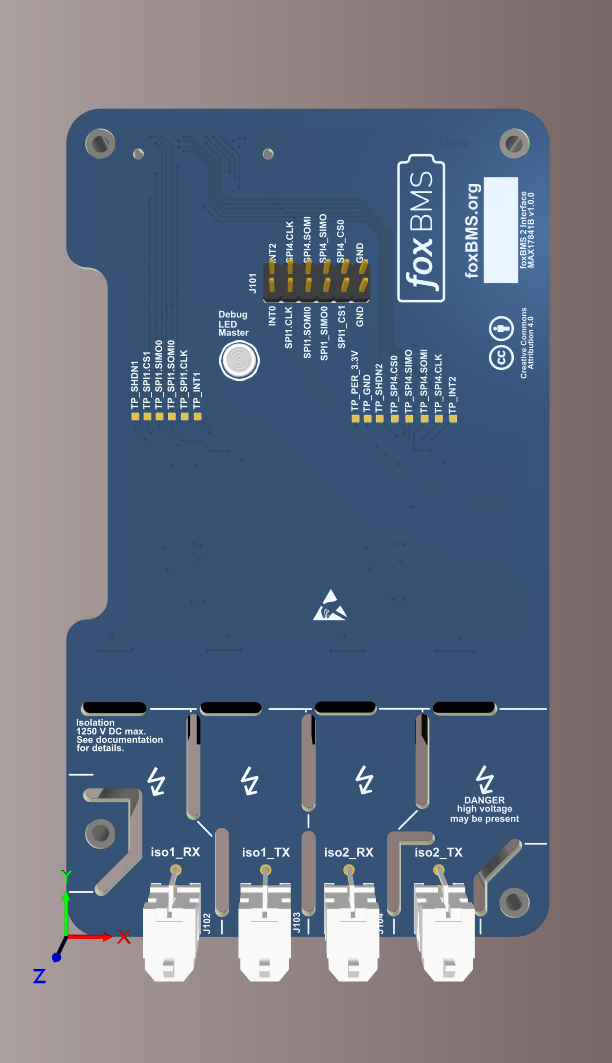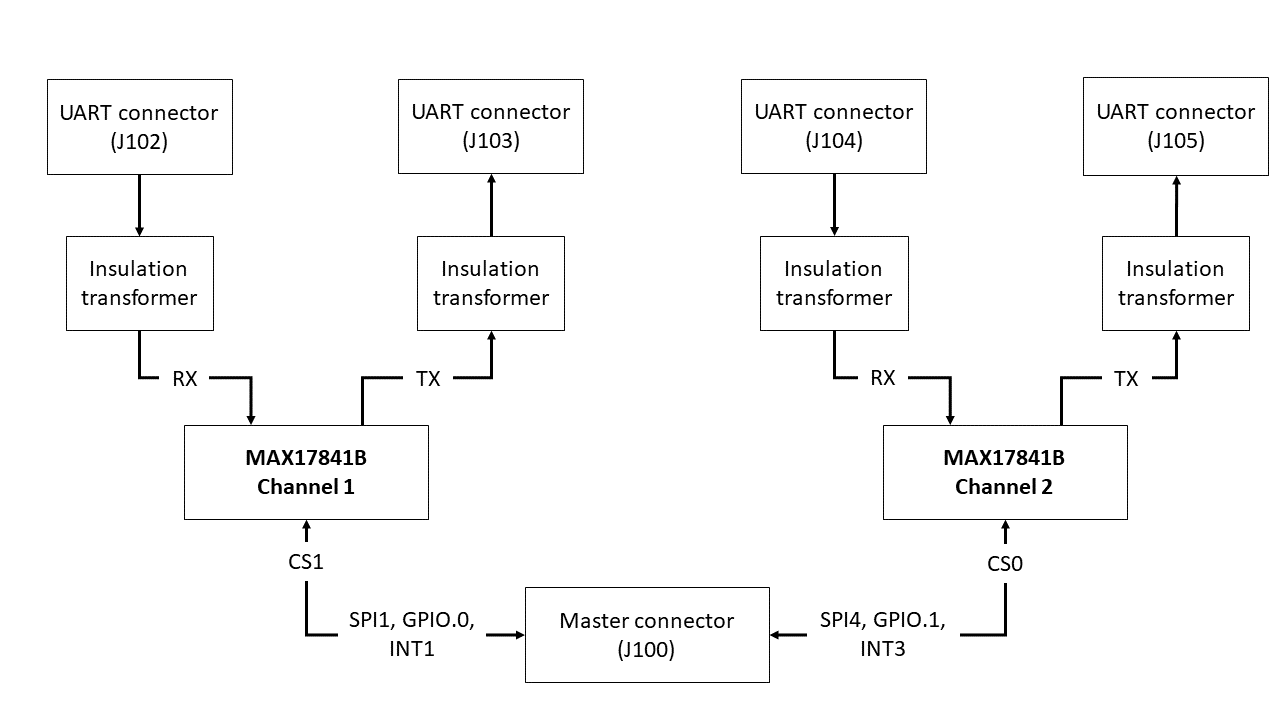6.3.2. Interface MAX17841B v1.0.0
6.3.2.1. Overview
Important
The following description only applies for the Maxim MAX17841B-based
BMS-Interface hardware version 1.0.0.
Hint
All connector pinouts described below follow the Convention for Molex Micro-Fit 3.0 Connector Pin Numbering and Convention for Samtec Edge Rate connectors.
The BMS-Interface is used to enable communication between the BMS-Master and the BMS-Slaves. A 3D rendering from the TOP side view of the BMS-Interface is shown in Fig. 6.4. The BMS-Interface is intended to be used together with a BMS-Master.

Fig. 6.4 3D rendering of the BMS-Interface
6.3.2.2. Specifications
6.3.2.2.1. Mechanical Dimensions
The size of the PCB is 70 mm x 120 mm. A 3D-model and a drawing of the PCB can be found in Design Resources
6.3.2.2.2. Battery Management UART Insulation
The interface board is designed for a maximum continuous insulation voltage of 1250 V DC between all two Maxim Battery Management UART channels and between each Maxim Battery Management UART channel and the BMS-Master.
The insulation is designed according to DIN EN 60664-1:2008-01 under the following conditions:
Type of insulation: functional
Electrical field: homogeneous
Pollution degree: 2
PCB insulator class: 3b
Transient voltage: 4300 V DC
Continuous (working) voltage: 1250 V DC (selected due to design space constraints on PCB)
The PCB design complies with the following parameters:
Clearance: 1.3 mm
Creepage distance: 12.5 mm
6.3.2.2.3. Block Diagram
A block diagram of the BMS-Interface is shown in Fig. 6.5.

Fig. 6.5 Block diagram of the BMS-Interface
Each Maxim MAX17841B communication chip from Maxim Integrated provides one UART channel. Each channel is comprised of a RX and a TX signal, each using one insulation transformer. The Maxim MAX17841B chips are directly connected to the MCU via SPI.
6.3.2.2.4. Schematic and Board Layout
More information about the board schematic and layout files can be found in section Design Resources. For better debugging, there are test-points on the PCB for all relevant IO signals. In addition to test-points, a pin header (J101) allows an easier connection to a logic analyzer.
6.3.2.3. Functions
6.3.2.3.1. Maxim Battery Management UART communication
The BMS-Interface offers up to two isolated Maxim Battery Management UART communication channels using the Maxim MAX17841B transceiver chip from Maxim Integrated. The Maxim MAX17841B transceivers are controlled by the SPI signals from the BMS-Master. The UART RX signals are available on the connectors J102 and J104. The pinout of the connectors is described in Table 6.3.
Pin |
Signal |
Description |
|---|---|---|
1 |
UART_RX_p |
UART RX positive |
2 |
UART_RX_n |
UART RX negative |
The UART TX signals are available on the connectors J103 and J105. The pinout of the connectors is described in Table 6.4.
Pin |
Signal |
Description |
|---|---|---|
1 |
UART_TX_p |
UART TX positive |
2 |
UART_TX_n |
UART TX negative |
For the connection to the BMS-Master, a 40-pole mezzanine connector (J100) is used. The pinout and pin usage is described in Table 6.5
Pin |
Signal |
Description |
Usage on BMS-Interface |
|---|---|---|---|
1 |
|
- |
UART channel 1 |
2 |
|
- |
- |
3 |
|
- |
UART channel 1 |
4 |
|
- |
- |
5 |
|
- |
UART channel 1 |
6 |
|
- |
UART channel 1 |
7 |
|
- |
- |
8 |
|
- |
- |
9 |
|
- |
- |
10 |
|
- |
- |
11 |
|
- |
UART channel 2 |
12 |
|
- |
UART channel 2 |
13 |
|
- |
UART channel 2 |
14 |
|
- |
UART channel 2 |
15 |
|
- |
- |
16 |
|
- |
- |
17 |
|
- |
- |
18 |
|
- |
- |
19 |
|
- |
- |
20 |
|
Interrupt pin, connected to MCU GIOA_2 |
UART channel 1 [max17841b] interrupt |
21 |
|
Interrupt pin, connected to MCU GIOA_3 |
UART channel 1 [max17841b] enable |
22 |
|
Interrupt pin, connected to MCU GIOA_4 |
UART channel 2 [max17841b] interrupt |
23 |
|
Interrupt pin, connected to MCU GIOA_6 |
UART channel 2 [max17841b] enable |
24 |
|
GPIO pin, connected to port expander 3 IO1_0 |
UART channel 1 [max17841b] enable |
25 |
|
GPIO pin, connected to port expander 3 IO1_1 |
UART channel 2 [max17841b] enable |
26 |
|
GPIO pin, connected to port expander 3 IO1_2 |
- |
27 |
|
GPIO pin, connected to port expander 3 IO1_3 |
- |
28 |
|
GPIO pin, connected to port expander 3 IO1_4 |
- |
29 |
|
GPIO pin, connected to port expander 3 IO1_5 |
- |
30 |
|
GPIO pin, connected to port expander 3 IO1_6 |
- |
31 |
|
GPIO pin, connected to port expander 3 IO1_7 |
- |
32 |
|
Power supply ground |
Power supply ground |
33 |
|
Power supply ground |
Power supply ground |
34 |
|
3.3 V from peripheral SBC |
3.3 V power supply |
35 |
|
3.3 V from peripheral SBC |
3.3 V power supply |
36 |
|
5.0 V from peripheral SBC |
- |
37 |
|
5.0 V from peripheral SBC |
- |
38 |
|
12 V from buck-boost converter |
- |
39 |
|
Master supply voltage (after protection circuits) |
- |
40 |
|
Master supply voltage (after protection circuits) |
- |
All important IO signals are connected to a pin header (J101) to provide an easy connection to a logic analyzer. The pinout of this header is described in Table 6.6
Pin |
Signal |
Description |
|---|---|---|
1 |
|
- |
2 |
|
- |
3 |
|
UART channel 2 |
4 |
|
UART channel 1 |
5 |
|
UART channel 2 |
6 |
|
UART channel 1 |
7 |
|
UART channel 2 |
8 |
|
UART channel 1 |
9 |
|
UART channel 2 |
10 |
|
UART channel 1 |
11 |
|
UART channel 2 [max17841b] interrupt |
12 |
|
UART channel 1 [max17841b] interrupt |
